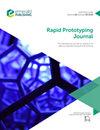Using adaptive slicing method and variable binder amount algorithm in binder jetting
IF 3.6
4区 工程技术
Q1 ENGINEERING, MECHANICAL
引用次数: 0
Abstract
Purpose Binder jetting is one of the essential additive manufacturing methods because it is cost-effective, has no thermal stress problems and has a wide range of different materials. Using binder jetting technology in the industry is becoming more common recently. However, it has disadvantages compared to traditional manufacturing methods regarding speed. This study aims to increase the manufacturing speed of binder jetting. Design/methodology/approach This study used adaptive slicing to increase the manufacturing speed of binder jetting. In addition, a variable binder amount algorithm has been developed to use adaptive slicing efficiently. Quarter-spherical shaped samples were manufactured using a variable binder amount algorithm and adaptive slicing method. Findings Samples were sintered at 1250°C for 2 h with 10°C/min heating and cooling ramp. Scanning electron microscope analysis, surface roughness tests, and density calculations were done. According to the results obtained from the analyzes, similar surface quality is achieved by using 38% fewer layers than uniform slicing. Research limitations/implications More work is needed to implement adaptive slicing to binder jetting. Because the software of commercial printers is very difficult to modify, an open-source printer was used. For this reason, it can be challenging to produce perfect samples. However, a good start has been made in this area. Originality/value To the best of the authors’ knowledge, the actual use of adaptive slicing in binder jetting was applied for the first time in this study. A variable binder amount algorithm has been developed to implement adaptive slicing in binder jetting.采用自适应切片法和变粘结剂量算法进行粘结剂喷射
目的粘结剂喷射是一种重要的增材制造方法,因为它具有成本效益,没有热应力问题,并且具有广泛的不同材料。最近,在工业中使用粘结剂喷射技术变得越来越普遍。然而,与传统的制造方法相比,它在速度方面存在缺点。本研究旨在提高粘结剂喷射的制造速度。设计/方法/方法本研究使用自适应切片来提高粘结剂喷射的制造速度。此外,还开发了一种可变粘结剂量算法,以有效地使用自适应切片。使用可变粘结剂量算法和自适应切片方法制造四分之一球形样品。发现样品在1250°C下烧结2 h,加热和冷却速度为10°C/min。进行了扫描电子显微镜分析、表面粗糙度测试和密度计算。根据分析结果,使用比均匀切片少38%的层可以获得类似的表面质量。研究局限性/含义需要做更多的工作来实现粘合剂喷射的自适应切片。由于商用打印机的软件很难修改,因此使用了开源打印机。因此,生产完美的样品可能具有挑战性。然而,在这方面已经有了一个良好的开端。独创性/价值据作者所知,本研究首次将自适应切片技术实际应用于粘结剂喷射中。开发了一种可变粘结剂量算法来实现粘结剂喷射中的自适应切片。
本文章由计算机程序翻译,如有差异,请以英文原文为准。
求助全文
约1分钟内获得全文
求助全文
来源期刊

Rapid Prototyping Journal
工程技术-材料科学:综合
CiteScore
8.30
自引率
10.30%
发文量
137
审稿时长
4.6 months
期刊介绍:
Rapid Prototyping Journal concentrates on development in a manufacturing environment but covers applications in other areas, such as medicine and construction. All papers published in this field are scattered over a wide range of international publications, none of which actually specializes in this particular discipline, this journal is a vital resource for anyone involved in additive manufacturing. It draws together important refereed papers on all aspects of AM from distinguished sources all over the world, to give a truly international perspective on this dynamic and exciting area.
-Benchmarking – certification and qualification in AM-
Mass customisation in AM-
Design for AM-
Materials aspects-
Reviews of processes/applications-
CAD and other software aspects-
Enhancement of existing processes-
Integration with design process-
Management implications-
New AM processes-
Novel applications of AM parts-
AM for tooling-
Medical applications-
Reverse engineering in relation to AM-
Additive & Subtractive hybrid manufacturing-
Industrialisation
 求助内容:
求助内容: 应助结果提醒方式:
应助结果提醒方式:


